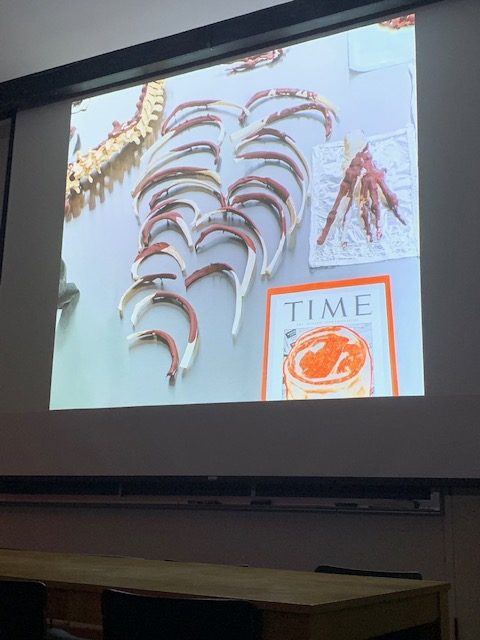
Photo from Flickr.
While explaining the relationship between the term “cannibalism” and Mexican cacao, Minerva Cuevas projected an image of bones dipped in chocolate. She goes on to explain how the term cannibalism was often used to justify the colonization and exploitation of Mexico’s people and land.
The image was one of many displayed as the renowned conceptual artist Minerva Cuevas gave an art lecture at Mills College’s Danforth Lecture Hall last month.
Cuevas’s art lecture was part of the annual art lecture series organized by students and faculty within the studio art MFA program here at Mills.
“It was also very difficult to work with Mexican chocolate,” Cuevas said, recalling the “Feast and Famine” installation she held in Mexico. “All the Mexican cacao is being exported to Switzerland and Belgium, and the industry is usually using the African one, of course, due to the price difference,” she continued, describing her struggle in finding authentic Mexican chocolate to create her silkscreens (a printmaking technique).

Photo by Tyler Mendoza.
Born and raised in Mexico, Cuevas explained in a LACAP (Latin American Canadian Art Project) interview how she taught herself video installation and performance art for her first production, as her education at Visual Arts in Mexico City was “very classic.”
Cuevas shared with LACAP how she merged her political interests with art production, which eventually lead to her notable project, “Better Life Corporation (Mejor Vida).”
Established in response to capitalist practices, Cuevas created Mejor Vida Corporation in 1998. The project provides free services and products, such as writing recommendation letters, creating student ID cards and providing cheaper barcode stickers to put on food sold at your local supermarket.
Like the Mejor Vida project, Cuevas centers her artworks around what she calls political and social “interventions,” such as the live demonstration of creating a chocolate volcano.
Cuevas projected images of the chocolate volcano, and the machine which hovered over it, for the Mills community. The images showed the machine creating the drips of chocolate which formed the volcano. “Every time the chocolate drips, one person dies of starvation in the world—and that’s every 3.6 seconds,” explained Cuevas.

She also displayed images of a public action project she conducted in 2005, held in a neighborhood in Spain. Having learned that this musician-filled neighborhood in Spain was in its early stages of gentrification, Cuevas invited local musicians to play a concert in the area. Cuevas paid 50 local musicians to play their genre of music at the concert and she described how the musicians came from different genres such as samba, classical and punk rock.
The result?
“Well, I thought it was going to be an orchestral noise because of this combination. They didn’t have anyone directing them, they didn’t have any rehearsal, they just had to play for a half–hour there,” she recalls. “But what happened was that, of course, they are musicians. It’s a language and they had harmony; they could communicate.”
To Cuevas’s surprise, the impromptu band continued to play a half–hour more than they were scheduled for.
Looking up at the photos of the musicians, she smiles saying, “For me, it’s also an example of how I understand art or the potential of art. … It’s the putting together some elements without being able to guess what is going to be the result… sometimes there are very good surprises,” Cuevas said.
